#marion barber
Text
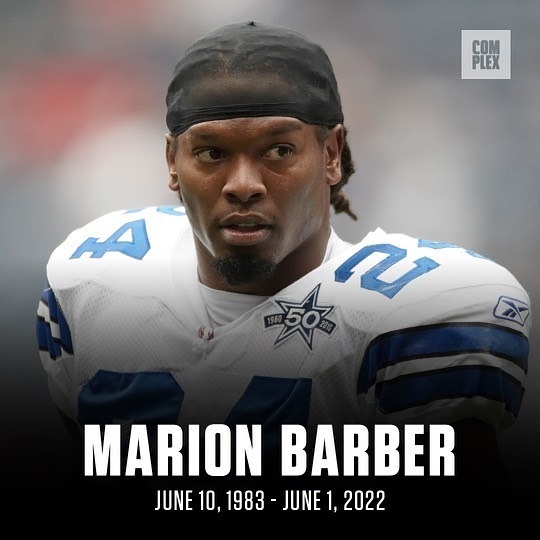
Former Cowboys RB Marion Barber was found dead in his apartment in Frisco, TX on Wednesday. He was 38.
IG: complexsports (6/1/22)
17 notes
·
View notes
Text
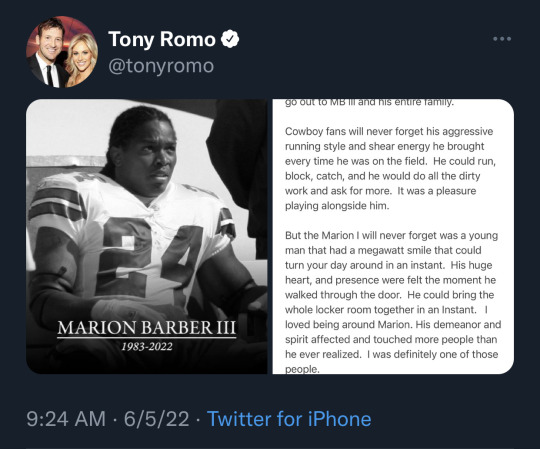

#marion barber#marion barber iii#marion the barbarian#rest in peace#tony romo#dallas cowboys#nfl#cowboys#national football league
11 notes
·
View notes
Video
youtube
Remembering Marion Barber III
#dallas cowboys#minnesota#legend#great#running back#youtube#rest peacefully#marion barber#rb#24#remembering marian barber iii#love your people#love your family#love yourselves#check on your friends#lets help each other
0 notes
Text
Cowboys say former running back Marion Barber dead at 38
Cowboys say former running back Marion Barber dead at 38
FRISCO, Texas — Marion Barber III, the former Dallas Cowboys running back who is fourth in franchise history with 47 rushing touchdowns, has died, the team said Wednesday. He was 38.
Barber played a final season with Chicago in 2011 after spending his first six years with the Cowboys. He had issues with mental health after his career.
Police in the Dallas suburb of Frisco said Wednesday they made…
View On WordPress
#arts and entertainment#barber#Celebrity#Celebrity deaths#Cowboys#dead#entertainment#Ezekiel Elliott#football#Laurence Maroney#Marion#Marion Barber#national football conference#National Football League#nfl football#Obituaries#Professional football#running#Sports#Thomas Barber
0 notes
Text
Former Dallas Cowboys Player Marion Barber Found Dead At 38
Former Dallas Cowboys Player Marion Barber Found Dead At 38
#Marion Barber#dallas cowboys#nfl football#Running back#Football#national football league#Celebrity death#tw celebrity death
0 notes
Text
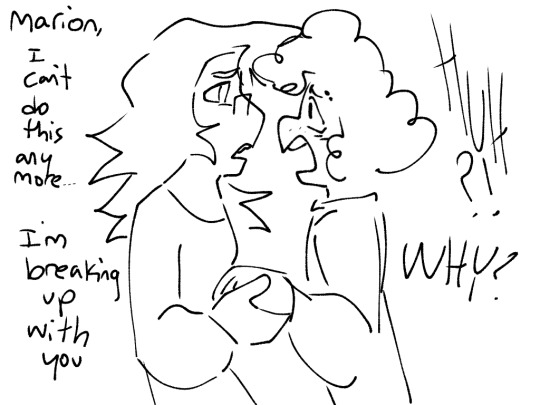

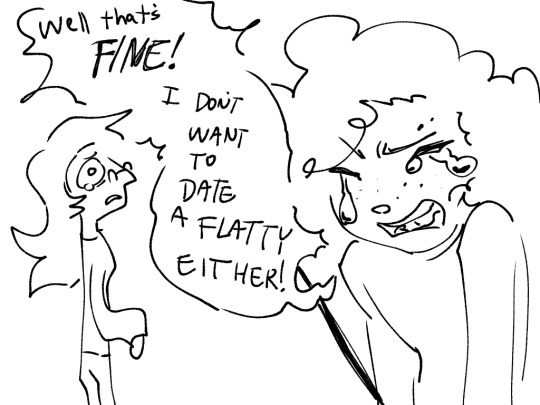
If you add their ass mass together you get -4
#em draws shit#art#doodle#half heart#marion enneson#pamella casson#have you guys ever become suddenly aware of the fact marion and pam both have those ear covering hair parts that stick into their faces#whats with that. and they both have side parts#maybe they go to the same barber
41 notes
·
View notes
Photo

[I haven’t properly introduced this couple yet, but here’s Sarah Barber and Reginald II Barber; the Barber family is the newest addition to Whibley, they were created for RBU backstory. They’re good friends with Gordon and Maggie and have been ever since college.]
#playing whibley#sarah barber#reginald ii barber#marion family#year 2#sims 2#ts2#whibley#the early years
2 notes
·
View notes
Text

“Looking at Appalachia.” Jesse Barber. 12/1/19. Marion, McDowell County, NC.
#north carolina#southern gothic#rural gothic#rural aesthetic#small town america#churchyard#appalachia#mcdowell#after hours#liminal reality#regional gothic#rural life#old church#red cross#red light#grunge#gothcore
5K notes
·
View notes
Text
This is why we still need Women’s History Month.
By Martha Gill
What was life like for women in medieval times? “Awful” is the vague if definite answer that tends to spring to mind – but this is an assumption, and authors have been tackling it with new vigour.
The Once and Future Sex: Going Medieval on Women’s Roles in Society by Eleanor Janega, and The Wife of Bath: A Biography by Marion Turner both contend that women were not only bawdier but busier than we thought: they were brewers, blacksmiths, court poets, teachers, merchants, and master craftsmen, and they owned land too. A woman’s dowry, Janega writes, was often accompanied with firm instructions that property stay with her, regardless of what her husband wanted.
This feels like a new discovery. It isn’t, of course. Chaucer depicted many such cheerfully domineering women. The vellum letter-books of the City of London, in which the doings of the capital from 1275 to 1509 were scribbled, detail female barbers, apothecaries, armourers, shipwrights and tailors as a matter of course. While it is true that aristocratic women were considered drastically inferior to their male equivalents – traded as property and kept as ornaments – women of the lower orders lived, relatively, in a sort of rough and ready empowerment.
It was the Renaissance that vastly rolled back the rights of women. As economic power shifted, the emerging middle classes began aping their betters. They confined their women to the home, putting them at the financial mercy of men. Female religious power also dwindled. In the 13th century seeing visions and hearing voices might get a woman sainted; a hundred years later she’d more likely be burned at the stake.
“When it comes to the history of gender relations, storytellers portray women as more oppressed than they actually were”
Why does this feel like new information? Much of what we think we know about medieval times was invented by the Victorians, who had an artistic obsession with the period, and through poetry and endless retellings of the myth of King Arthur managed somehow to permanently infuse their own sexual politics into it. (Victorian women were in many respects more socially repressed than their 12th-century forebears.)
But modern storytellers are also guilty of sexist revisionism. We endlessly retread the lives of oppressed noblewomen, and ignore their secretly empowered lower-order sisters. Where poorer women are mentioned, glancingly, they are pitied as prostitutes or rape victims. Even writers who seem desperate for a “feminist take” on the period tend to ignore the angle staring them right in the face. In her 2022 cinematic romp, Catherine called Birdy, for example, Lena Dunham puts Sylvia Pankhurst-esque speeches into the mouth of her 13th-century protagonist, while portraying her impending marriage – at 14 – as normal for the period. (In fact the average 13th-century woman got married somewhere between the ages of 22 and 25.)
But we cling tight to these ideas. It is often those who push back against them who get accused of “historical revisionism”. This applies particularly to the fantasy genre, which aside from the odd preternaturally “feisty” female character, tends to portray the period as, well, a misogynistic fantasy. The Game of Thrones author George RR Martin once defended the TV series’ burlesque maltreatment of women on the grounds of realism. “I wanted my books to be strongly grounded in history and to show what medieval society was like.” Oddly enough, this didn’t apply to female body hair (or the dragons).
This is interesting. Most of our historical biases tend to run in the other direction: we assume the past was like the present. But when it comes to the history of gender relations, the opposite is true: storytellers insist on portraying women as more oppressed than they actually were.
“The history of gender relations might be more accurately painted as a tug of war between the sexes”
The casual reader of history is left with the dim impression that between the Palaeolithic era and the 19th century women suffered a sort of dark age of oppression. This is assumed to have ended some time around the invention of the lightbulb, when the idea of “gender equality” sprang into our heads and right-thinking societies set about “discovering” female competencies: women – astonishingly – could do
things men could do!
In fact the history of gender relations might be more accurately painted as a tug of war between the sexes, with women sometimes gaining and sometimes losing power – and the stronger sex opportunistically seizing control whenever it had the means.
In Minoan Crete, for example, women had similar rights and freedoms to men, taking equal part in hunting, competitions, and celebrations.
But that era ushered in one of the most patriarchal societies the planet has ever known – classical Greece, where women had no political rights and were considered “minors”.
Or take hunter-gatherer societies, the source of endless cod-evolutionary theories about female inferiority. The discovery of female skeletons with hunting paraphernalia has disproved the idea that men only hunted and women only gathered – and more recently anthropologists have challenged the idea that men had higher status too: women, studies contend, had equal sway over group decisions.
This general bias has had two unfortunate consequences. One is to impress upon us the idea that inequality is “natural”. The other is to give us a certain complacency about our own age: that feminist progress is an inevitable consequence of passing time. “She was ahead of her time,” we say, when a woman seems unusually empowered. Not necessarily.
Two years ago, remember, sprang up one of the most vicious patriarchies in history – women were removed from their schools and places of work and battoned into homes and hijabs. And last year in the US many women lost one of their fundamental rights: abortion. (Turns out it was pro-lifers, not feminists, who were ahead of their time there.)
Both these events were greeted with shock from liberal quarters: how could women’s rights be going backwards? But that only shows we should brush up on our history. Another look at medieval women is as good a place to start as any.
Martha Gill is a political journalist and former lobby correspondent
#Women’s History#books for women#The Once and Future Sex: Going Medieval on Women’s Roles in Society#Eleanor Janega#The Wife of Bath: A Biography#Marion Turner
711 notes
·
View notes
Text
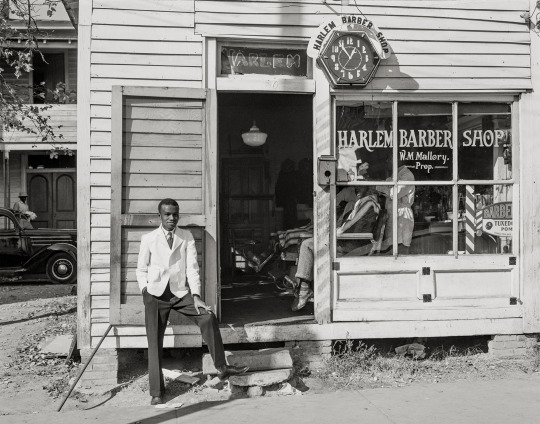
Harlem Barber Shop. Granville County, NC - 1939
Photographer: Marion Wolcott
18 notes
·
View notes
Text

Coretta Scott was the third of four children born to Obadiah "Obie" Scott (1899–1998) and Bernice McMurry Scott (1904–1996) in Marion, Alabama.
She was born in her parents' home with her paternal great-grandmother Delia Scott, a former slave, presiding as midwife.
Coretta's mother became known for her musical talent and singing voice. As a child Bernice attended the local Crossroads School and only had a fourth grade education. Bernice's older siblings, however, attended boarding school at the Booker T. Washington founded Tuskegee Institute. The senior Mrs. Scott worked as a school bus driver, a church pianist, and for her husband in his business ventures. She served as Worthy Matron for her Eastern Star chapter and was a member of the local Literacy Federated Club.
Obie, Coretta's father, was the first black person in their neighborhood to own a truck. Before starting his own businesses he worked as a fireman. Along with his wife, he ran a barber shop from their home and later opened a general store. He also owned a lumber mill, which was burned down by white neighbors after Scott refused to sell his mill to a white logger.
Her maternal grandparents were Mollie (née Smith; 1868 - d.) and Martin van Buren McMurry (1863 - 1950) - both were of African-American and Irish descent. Mollie was born a slave to plantation owner Jim Blackburn and Adeline (Blackburn) Smith.
Coretta's maternal grandfather, Martin, was born to a slave of Black Native American ancestry, and her white master who never acknowledged Martin as his son. He eventually owned a 280-acre farm.
Because of his diverse origins, Martin appeared to be White; however, he displayed contempt for the notion of passing. As a self-taught reader with little formal education, he is noted for having inspired Coretta's passion for education.
Coretta's paternal grandparents were Cora (née McLaughlin; 1876 - 1920) and Jefferson F. Scott (1873 - 1941). Cora passed away before Coretta's birth. Jeff Scott was a farmer and a prominent figure in the rural black religious community; he was born to former slaves Willis and Delia.
Coretta Scott's parents intended for all of their children to be educated. Coretta quoted her mother as having said, "My children are going to college, even if it means I only have but one dress to put on."
#coretta scott king#her family#descendants#read about her#black history#african american history#knowledge is power
5 notes
·
View notes
Text

💈The Interesting History of the Barber Pole:
The barber pole’s colors are a legacy of a long-gone era when people went to barbers not just for a haircut or shave but also for bloodletting and other medical procedures. Red is for the bloody bandages from bloodletting, White is for the bandages the patients gripped and Blue is for patriotism.
During the Middle Ages bloodletting, which involves cutting open a vein and allowing blood to drain, was a common treatment for a wide range of maladies, from sore throat to plague. Monks, who often cared for the sick, performed the procedure, and barbers, given their skill with sharp instruments, sometimes provided assistance.
After Pope Alexander III in 1163 prohibited clergymen from carrying out the procedure, barbers added bloodletting—something physicians of the day considered necessary but too menial to do themselves–to their repertoires. Known as barber-surgeons, they also took on such tasks as pulling teeth, setting bones and treating wounds.
The look of the barber pole is linked to bloodletting, with red representing blood and white representing the bandages used to stem the bleeding. The pole itself is said to symbolize the stick that a patient squeezed to make the veins in his arm stand out more prominently for the procedure.
In Europe, barber poles traditionally are red and white, while in America, the poles are red, white and blue. One theory holds that blue is symbolic of the veins cut during bloodletting, while another interpretation suggests blue was added to the pole as a show of patriotism and a nod to the nation’s flag.
By the mid-1500s, English barbers were banned from providing surgical treatments, although they could continue extracting teeth. Both barbers and surgeons, however, remained part of the same trade guild until 1745.
While bloodletting largely fell out of favor with the medical community in the 19th century, it’s still used today to treat a small number of conditions.
*Pictured is Buford’s Family Barber in Downtown Marion, NC. 2007.
(Information from the History Channel)
2 notes
·
View notes
Text
ANDERSON, Ind. — A man accused of fatally shooting an Indiana police officer during a traffic stop had made a song about killing an officer, investigators said Monday.
Carl Boards II was charged with murder and other crimes, a day after Elwood Officer Noah Shahnavaz was gunned down Sunday morning in Madison County, about 50 miles northeast of Indianapolis.
The 24-year-old officer was shot in the head after stopping Boards' car. Investigators found 36 rifle bullet casings and damage to the patrol car's hood, windshield and driver’s door.
Shahnavaz' gun was still in its holster when he was taken to a hospital, Richard Clay of the Indiana State Police said in a court filing.
Boards, 42, owns a barber shop in Marion, Indiana. Police went to the shop and interviewed a man who lives in an apartment above the business.
The man indicated that Boards “made a recorded song making statements that if he was ever caught by police that he would kill them,” Clay said.
Boards was released from parole a year ago. His criminal record goes back to 1999 and includes convictions involving guns and drugs, Clay said.
It wasn't immediately know if Boards has an attorney yet who could comment on the allegations.
Shahnavaz served in the U.S. Army for five years before becoming a police officer about a year ago.
“His dream was to serve others and we are proud of what he accomplished in such a short time, both in the military and with Elwood police,” Fishers High School Principal Jason Urban said. “The entire FHS Tiger family grieves this tragic loss of such a promising young man full of talent and potential.”
6 notes
·
View notes
Text
Former NFL running back Marion Barber was found dead in Texas : NPR
Former NFL running back Marion Barber was found dead in Texas : NPR
Police found Marion Barber’s body in an apartment in Frisco, Texas. The former Dallas Cowboys running back is seen here in 2010.
NFL via Getty Images
hide caption
toggle caption
NFL via Getty Images
Police found Marion Barber’s body in an apartment in Frisco, Texas. The former Dallas Cowboys running back is seen here in 2010.
NFL via Getty Images
Former NFL running back Marion Barber has…

View On WordPress
0 notes
Photo

"Marion Barber III, Bruising Running Back for Cowboys, Dies at 38" by Richard Sandomir via NYT Sports https://ift.tt/7g41Jqm
5 notes
·
View notes
Text
442: Monkeying Around With Liz Cambage
442: Monkeying Around With Liz Cambage
Rod, Karen and Justin are joined by Dominic Rivera of The Mind With Dom Podcast to discuss listener feedback, NBA playoffs, Liz Cambage with the ‘cism, Lebron is a billionaire, Jaylen Brown signs with Kanye, Josh Donaldson apology, NFL working with HBCUs, Lionel Messi had long covid, Jeff Gladney dies in car crash, Nick Saban updates, Jerry Jeudy charges may be dropped, Marion Barber found dead,…

View On WordPress
1 note
·
View note